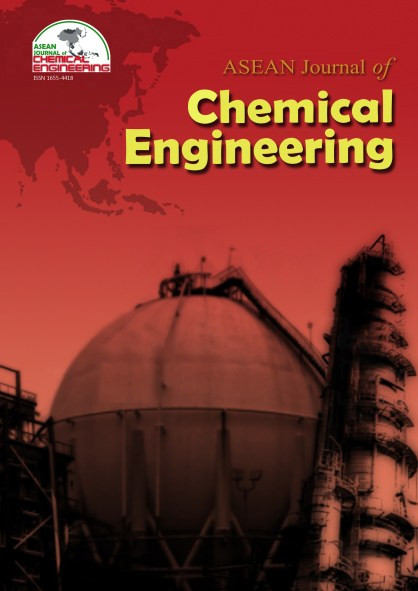Effects Of Cu On The Modified Co-Based Catalyst Activity For Fischer-Tropsch Synthesis
Abstract
Future fuel scarcity issue has become major concern for many energy security policies. As a very potential process to produce fuel, Fischer-Tropsch synthesis (FTS) with cobalt-based catalyst has been developed to produce wax as feedstock for further catalytic cracking. Therefore, this research was conducted to observe Co/Al2O3 catalyst properties enhancement through support pre-treatment using NH4NO3 and Cu promoter addition toward higher activity and selectivity. Catalysts were prepared by dry impregnation method. XRD, BET and TPR analyses were performed to characterize catalysts properties. Activity tests showed CO conversion, H2 conversion and selectivity of C5+ were in the range of 25.1% to 96.2%, 24.2% to 83.7% and 53.5% to 75.9% respectively. Crystallography measurements exhibited 8.6-9.8 nm cobalt particles size. In this study, FTS was evaluated by using fixed-bed reactor at 20 bar, 250 C, and WHSV of 1500 ml/g.cat/h-1. Support pre-treatment increased the pore size of γ-Al2O3 and slightly enlarged cobalt diameter. While addition of Cu improved the reducibility of the catalyst.References
2. Borg, Ø., (2007). Role of Alumina Support in Cobalt Fischer-Tropsch Synthesis, Doctorate dissertation, Tronheim, Norwegian University of Science and Technology.
3. Catita, L. D. M., (2014). Search for New Innovating Catalyst for The Fischer-Tropsch Synthesis, Master Thesis, Institute of Technico Lisboa.
4. Dry, M. E., (1981). The Fischer-Tropsch Synthesis, In: Catalysis: Science and Technology, Anderson, J. R., and Boudart, M., (eds),Vol. 1, Springer-Verlag, New York
5. Jacobs, G., Ma, W., & Davis, B. H., (2014). Influence of Reduction Promoters on Stability of Cobalt/γ-Alumina Fischer-Tropsch Synthesis Catalysts. Journal of Catalyst, 4 , 49-76.
6. Jacobs, G., Ribeiroa, M. C., Ma, W., Jia, Y., Khalida, S., Sumodjo, P. T. A., & Davis, B. H., (2009) Group 11 (Cu, Ag, Au) Promotion of 15%Co/Al2O3 Fischer-Tropsch Synthesis Catalysts. Applied Catalysts A: General, 361, 137-151.
7. Li, C., Sun, Q., Cao, F., Ying, W., & Fang, D., (2007). Pretreatment of Alumina and Its Influence on The Properties of Co/Alumina Catalysts for Fischer Tropsch Synthesis. Journal of Natural Gas and Chemsitry, 16, 308-315.
8. Morales, F., & Weckhuysen, B. M., (2006). Promotion effects in Co-based Fischer Tropsch Catalysis. The royal society of Chemistry, 7, 45-52.
9. Schanke, D., Vada, S., Blekkan, E. A., Hilmen, A. M., Hoff, A., & Holmen, A., (1995) Study of Pt-promoted Cobalt CO Hydrogenation Catalyst. J. Catal.156 85–95.
10. Shimura, K., Miyazawa, T., Hanaoka, T., & Hirata, S., (2014). Fischer-Tropsch Synthesis over Alumina Supported Cobalt Catalyst: Effect of Crystal Phase and Pore Structure of Alumina Support. Journal of Molecular Catalysis A: Chemical, 394, 22–32.
11. Surisetty, V. R., Dalai, A. K., & Kozinski, J., (2010). Alkali-Promoted Trimetallic Co−Rh−Mo Sulfide Catalysts for Higher Alcohols Synthesis from Synthesis Gas: Comparison of MWCNT and Activated Carbon Supports. Ind. Eng. Chem. Res.49 (15), 6956–6963.
12. Wang, W. J., & Chen, Y. W., (1991). Influence of metal loading on the reducibility and hydrogenation activity of cobalt/alumina catalysts. Appl. Catal., 77, 223–233.
13. Zhang, J. C., Chen, J., Ren, J., & Sun, Y., (2003). Chemical treatment of γ-Al2O3 and its influence on the properties of Co-based catalysts for Fischer–Tropsch synthesis. Applied Catalysis A: General, 243, 121-133.
Copyright holder for articles is ASEAN Journal of Chemical Engineering. Articles published in ASEAN J. Chem. Eng. are distributed under a Creative Commons Attribution-NonCommercial 4.0 International (CC BY-NC 4.0) license.
Authors agree to transfer all copyright rights in and to the above work to the ASEAN Journal of Chemical Engineering Editorial Board so that the Editorial Board shall have the right to publish the work for non-profit use in any media or form. In return, authors retain: (1) all proprietary rights other than copyright; (2) re-use of all or part of the above paper in their other work; (3) right to reproduce or authorize others to reproduce the above paper for authors’ personal use or for company use if the source and the journal copyright notice is indicated, and if the reproduction is not made for the purpose of sale.



